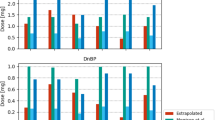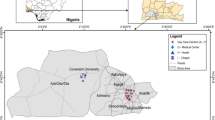Abstract
To assess the influence of clothing on dermal uptake of semi-volatile organic compounds (SVOCs), we measured uptake of selected airborne phthalates for an individual wearing clean clothes or air-exposed clothes and compared these results with dermal uptake for bare-skinned individuals under otherwise identical experimental conditions. Using a breathing hood to isolate dermal from inhalation uptake, we measured urinary metabolites of diethylphthalate (DEP) and di-n-butylphthalate (DnBP) from an individual exposed to known concentrations of these compounds for 6 h in an experimental chamber. The individual wore either clean (fresh) cotton clothes or cotton clothes that had been exposed to the same chamber air concentrations for 9 days. For a 6-h exposure, the net amounts of DEP and DnBP absorbed when wearing fresh clothes were, respectively, 0.017 and 0.007 μg/kg/(μg/m3); for exposed clothes the results were 0.178 and 0.261 μg/kg/(μg/m3), respectively (values normalized by air concentration and body mass). When compared against the average results for bare-skinned participants, clean clothes were protective, whereas exposed clothes increased dermal uptake for DEP and DnBP by factors of 3.3 and 6.5, respectively. Even for non-occupational environments, wearing clothing that has adsorbed/absorbed indoor air pollutants can increase dermal uptake of SVOCs by substantial amounts relative to bare skin.
This is a preview of subscription content, access via your institution
Access options
Subscribe to this journal
Receive 6 print issues and online access
$259.00 per year
only $43.17 per issue
Buy this article
- Purchase on Springer Link
- Instant access to full article PDF
Prices may be subject to local taxes which are calculated during checkout




Similar content being viewed by others
References
Rehal B, Maibach H . Percutaneous absorption of vapors in human skin. Cutan Ocul Toxicol 2011; 30: 87–91.
Rauma M, Boman A, Johanson G . Predicting the absorption of chemical vapours. Adv Drug Deliv Rev 2013; 65: 306–314.
Piotrowski J . Further investigations on the evaluation of exposure to nitrobenzene. Br J Ind Med 1967; 24: 60–65.
Piotrowski J . Evaluation of exposure to phenol: absorption of phenol vapour in the lungs and through the skin and excretion of phenol in urine. Br J Ind Med 1971; 28: 172–178.
Weschler CJ, Nazaroff WW . SVOC exposure indoors: fresh look at dermal pathways. Indoor Air 2012; 22: 356–377.
Weschler CJ, Nazaroff WW . Dermal uptake of organic vapors commonly found in indoor air. Environ Sci Technol 2014; 48: 1230–1237.
Gong M, Zhang Y, Weschler CJ . Predicting dermal absorption of gas-phase chemicals: transient model development, evaluation, and application. Indoor Air 2014; 24: 292–306.
Weschler CJ, Bekö G, Koch HM, Salthammer T, Schripp T, Toftum J et al. Transdermal uptake of diethyl- and di(n-butyl) phthalate directly from air: experimental verification. Environ Health Perspect 2015; doi:10.1289/ehp.1409151.
Blum A, Gold MD, Ames BN, Jones FR, Hett EA, Dougherty RC et al. Children absorb tris-BP flame retardant from sleepwear: urine contains the mutagenic metabolite, 2,3-dibromopropanol. Science 1978; 201: 1020–1023.
Appel KE, Gundert-Remy U, Fischer H, Faulde M, Mross KG, Letzel S et al. Risk assessment of Bundeswehr (German Federal Armed Forces) permethrin-impregnated battle dress uniforms (BDU). Int J Hyg Environ Health 2008; 211: 88–104.
Rossbach B, Appel KE, Mross KG, Letzel S . Uptake of permethrin from impregnated clothing. Toxicol Lett 2010; 192: 50–55.
Kegel P, Letzel S, Rossbach B . Biomonitoring in wearers of permethrin impregnated battle dress uniforms in Afghanistan and Germany. Occup Environ Med 2014; 71: 112–117.
Schripp T, Salthammer T, Fauck C, Bekö G, Weschler CJ . Latex paint as a delivery vehicle for diethylphthalate and di-n-butylphthalate: predictable boundary layer concentrations and emission rates. Sci Total Environ 2014; 494: 299–305.
Koch HM, Gonzalez-Reche LM, Angerer J . On-line clean-up by multidimensional liquid chromatography-electrospray ionization tandem mass spectrometry for high throughput quantification of primary and secondary phthalate metabolites in human urine. J Chromatogr B Analyt Technol Biomed Life Sci 2003; 784: 169–182.
Koch HM, Christensen KLY, Harth V, Lorber M, Brüning T . Di-n-butyl phthalate (DnBP) and diisobutyl phthalate (DiBP) metabolism in a human volunteer after single oral doses. Arch Toxicol 2012; 86: 1829–1839.
Koch HM, Becker K, Wittassek M, Seiwert M, Angerer J, Kolossa-Gehring M . Di-n-butylphthalate and butylbenzylphthalate—Urinary metabolite levels and estimated daily intakes: pilot study for the German Environmental Survey on children. J Expo Sci Environ Epidemiol 2007; 17: 378–387.
Koch HM, Lorber M, Christensen KLY, Pälmke C, Koslitz S, Brüning T . Identifying sources of phthalate exposure with human biomonitoring: results of a 48 h fasting study with urine collection and personal activity patterns. Int J Hyg Environ Health 2013; 216: 672–681.
USEPA Exposure Factors Handbook. 2011 edn, US Environmental Protection Agency: Washington, DC, USA. 2011.
Janjua NR, Frederiksen H, Skakkebæk NE, Wulf HC, Andersson A-M . Urinary excretion of phthalates and paraben after repeated whole-body topical application in humans. Int J Androl 2008; 31: 118–129.
Moore CA, Wilkinson SC, Blain PG, Dunn M, Aust GA, Williams FM . Use of a human skin in vitro model to investigate the influence of ‘every-day’ clothing and skin surface decontamination on the percutaneous penetration of organophosphates. Toxicol Lett 2014; 229: 257–264.
Gurunathan S, Robson M, Freeman N, Buckley B, Roy A, Meyer R et al. Accumulation of chlorpyrifos on residential surfaces and toys accessible to children. Environ Health Perspect 1998; 106: 9–16.
Morrison GC, Shakila N, Parker K . Accumulation of gas-phase methamphetamine on clothing, toy fabrics and skin oil. Indoor Air 2014; doi: 10.1111/ina.12159.
Fetter CW . Contaminant Hydrogeology. MacMillan Publishing Company: New York, NY, USA. 1993.
Mavruz S, Ogulata RT . Investigation of air permeability of single jersey fabrics with different relaxation states. J Text Inst 2011; 102: 57–64.
Ogulata RT, Mavruz S . Investigation of porosity and air permeability values of plain knitted fabrics. Fibres Text East Eur 2010; 82: 71–75.
Gibson PW, Desabrais K, Godfrey T . Dynamic permeability of porous elastic fabrics. J Eng Fiber Fabr 2012; 7: 29–36.
Ghaddar N, Ghali K, Harathani J, Jaroudi E . Ventilation rates of micro-climate air annulus of the clothing-skin system under periodic motion. Int J Heat Mass Transf 2005; 48: 3151–3166.
Lyman W, Reehl W, Rosenblatt D . Handbook of Chemical Property Estimation Methods. American Chemical Society: Washington, DC, USA, 1990.
Weschler CJ, Salthammer T, Fromme H . Partitioning of phthalates among the gas phase, airborne particles and settled dust in indoor environments. Atmos Environ 2008; 42: 1449–1460.
Noble RE . Environmental tobacco smoke uptake by clothing fabrics. Sci Total Environ 2000; 262: 1–3.
Chien Y-C, Chang C-P, Liu Z-Z . Volatile organics off-gassed among tobacco-exposed clothing fabrics. J Hazard Mater 2011; 193: 139–148.
Ueta I, Saito Y, Teraoka K, Miura T, Jinno K . Determination of volatile organic compounds for a systematic evaluation of third-hand smoking. Anal Sci 2010; 26: 569–574.
Tichenor BA, Sparks LE, Jackson MD, Guo Z, Mason Plunket MACM, Rasor SA . Emissions of perchloroethylene from dry cleaned fabrics. Atmospheric Environ Gen Top 1990; 24A: 1219–1229.
Chao CYH, Tung TCW, Niu JL, Pang SW, Lee RYM . Indoor perchloroethylene accumulation from dry cleaned clothing on residential premises. Build Environ 1998; 34: 319–328.
Thomas KW, Pellizzari ED, Perritt RL, Nelson WC . Effect of dry-cleaned clothes on tetrachloroethylene levels in indoor air, personal air, and breath for residents of several New Jersey homes. J Expo Anal Environ Epidemiol 1991; 1: 475–490.
Sherlach KS, Gorka AP, Dantzler A, Roepe PD . Quantification of perchloroethylene residues in dry-cleaned fabrics. Environ Toxicol Chem 2011; 30: 2481–2487.
Guerrero PA, Corsi RL . Emissions of p-dichlorobenzene and naphthalene from consumer products. J Air Waste Manag Assoc 2012; 62: 1075–1084.
Schreuder-Gibson H, Truong Q, Walker J, Owens J, Wander J, Jones W . Chemical and biological protection and detection in fabrics for protective clothing. MRS Bull 2003; 28: 574–578.
Piadé JJ, D’Andrés S, Sanders EB . Sorption phenomena of nicotine and ethenylpyridine vapors on different materials in a test chamber. Environ Sci Technol 1999; 33: 2046–2052.
Acknowledgements
The authors are grateful to Louise B. Weschler for her assistance with these experiments.
Author information
Authors and Affiliations
Corresponding author
Ethics declarations
Competing interests
The authors declare no conflict of interest.
Additional information
Supplementary Information accompanies the paper on the Journal of Exposure Science and Environmental Epidemiology website
Supplementary information
Rights and permissions
About this article
Cite this article
Morrison, G., Weschler, C., Bekö, G. et al. Role of clothing in both accelerating and impeding dermal absorption of airborne SVOCs. J Expo Sci Environ Epidemiol 26, 113–118 (2016). https://doi.org/10.1038/jes.2015.42
Received:
Accepted:
Published:
Issue Date:
DOI: https://doi.org/10.1038/jes.2015.42
Keywords
This article is cited by
-
Modeling clothing as a secondary source of exposure to SVOCs across indoor microenvironments
Journal of Exposure Science & Environmental Epidemiology (2023)
-
Effects of Temperature and Advanced Cleaning Practices on the Removal of Select Organic Chemicals from Structural Firefighter Gear
Fire Technology (2023)
-
Transdermal uptake of benzophenone-3 from clothing: comparison of human participant results to model predictions
Journal of Exposure Science & Environmental Epidemiology (2021)
-
Modeled exposure to phthalates via inhalation and dermal pathway in children’s sleeping environment: A preliminary study and its implications
Building Simulation (2021)
-
The impact of clothing on ozone and squalene ozonolysis products in indoor environments
Communications Chemistry (2019)



